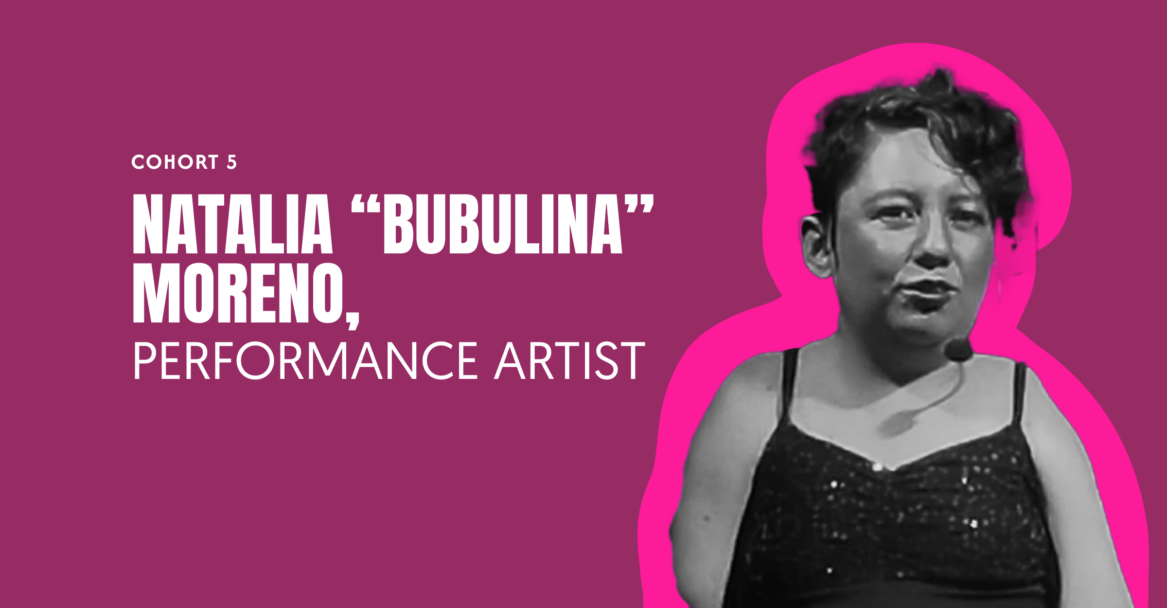Natalia “Bubulina” Moreno
PERFORMANCE ARTIST
COLOMBIA

Natalia “Bubulina” Moreno Rodriguez (she/her) is a woman with a physical disability, a social communicator, a human rights advocate and educator, a Latin American consultant, and an expert on the intersectionality between disability, gender, and sexual diversity. She loves body language, dance, and theatre, and has knowledge of Integrated Contemporary Dance. She creates and produces different types of art (dance, theatre, and performance), including the award-winning performance monologue called “Tentacles,” presented several times in different cities in Colombia, and also in countries such as Mexico and Nepal. It inspires audience and invites debate about experiences of exclusion and discrimination. She received a certificate as an Inclusive Contemporary Dance teacher with the DanceAbility Methodology in February 2012.
Explore Bubulina’s work on her website, follow her on Instagram, and read her interview below.
Natalia «Bubulina» Moreno Rodríguez (ella) es una mujer con discapacidad física, comunicadora social, defensora y educadora en derechos humanos, consultora latinoamericana y experta en la interseccionalidad entre discapacidad, género y diversidad sexual. Le encanta el lenguaje corporal, la danza y el teatro, y tiene conocimientos de Danza Contemporánea Integrada. Crea y produce diferentes tipos de arte (danza, teatro e interpretación), entre ellos el premiado monólogo performático «Tentáculos», presentado varias veces en diferentes ciudades de Colombia y también en países como México y Nepal. Inspira al público e invita al debate sobre las experiencias de exclusión y discriminación. Recibió un certificado como profesora de Danza Contemporánea Inclusiva con la Metodología DanceAbility en febrero de 2012.
Explore el trabajo de Bubulina en su página web, sígala en Instagram, y lea su entrevista a continuación.
The role that art can play for social change must be as an educator of cultural transformation, and always offering a critical stance about the oppression suffered by people who have been historically marginalized.Natalia “Bubulina” Moreno
What role do you think art can play in social change?
The role that art can play for social change must be as an educator of cultural transformation, and always offering a critical stance about the oppression suffered by people who have been historically marginalized.
¿Cuál crees que es el papel que juega el arte en el cambio social?
El papel que el arte puede desempeñar para el cambio social debe ser el de educador de la transformación cultural, ofreciendo siempre una postura crítica sobre la opresión que sufren las personas que han sido marginadas históricamente.
What are some of the impacts you’ve seen as a result of your performances?
People who have participated in my performances tell me that they will do something—take action—to contribute to social transformation from their privileged positions; others have told me they see themselves in my art and are motivated to empower themselves and defend their rights as a result.
¿Cuáles son algunos de los impactos que has visto como resultado de tus presentaciones?
Las personas que han participado en mis presentaciones me dicen que van a hacer algo, van a pasar a la acción, a contribuir a la transformación social desde sus posiciones privilegiadas; otras me han dicho que se ven reflejadas en mi arte y que, como consecuencia, se sienten motivadas para empoderarse y defender sus derechos.
What do you hope to achieve through this award?
I want to engage more people like me to follow this path in the field of emerging arts as a form of emancipation.
¿Qué esperas conseguir con este premio?
Quiero conseguir que más gente como yo siga este camino en el campo de las artes emergentes como forma de emancipación.
Featured work

“Tentacles Monologue” showcases the stereotyped image of people with disabilities and their insertion in an infantilized world that does not facilitate the development of femininity and masculinity. It is not a pretentious project that intends to reveal all the interstices of this complex, multifaceted and polyphonic world, rather, it’s part of the first-person narrative of Natalia Moreno.